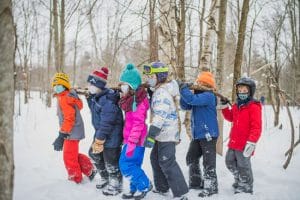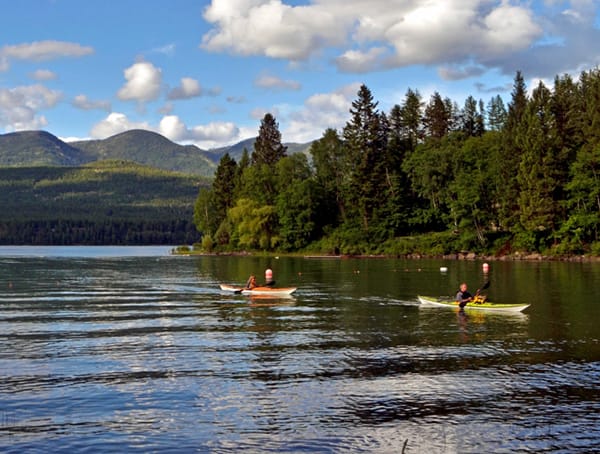Climate change is a sprawling urgent “code red” crisis for the planet. But even if you can grasp the implications of melting Arctic permafrost or bleaching Atlantic coral, those threats and their solutions can feel distant. It’s easier—and usually more effective—to lean into the climate threats and solutions that are closer to home.
Therein lies one of the many climate benefits of land conservation—more specifically, strategic, localized conservation. Trust for Public Land uses data to pinpoint and pursue the projects—from a few hundred acres to tens of thousands of acres—with the greatest potential to capture and store carbon while prioritizing community climate resilience. Help us make an impact.
Despite the importance and popularity of our forests, they face unprecedented threats. Take action now and urge Congress to protect our country’s forests by signing our petition today!
Thinking Global: Reduce Carbon Emissions. Increase Carbon Storage.
Cutting carbon emissions is paramount, of course. But Brendan Shane, climate director at Trust for Public Land, says that even if societies stopped releasing all heat-trapping gases into the atmosphere tomorrow, we would still need to harness the power of plants and trees to avoid the worst scenarios under a warming planet.
“We have emitted so much carbon that even when we get to zero emissions—when we all have electric cars and electric stoves and we use hydrogen to fly planes—the atmosphere will continue to warm,” he explains.
“So we need to double down on nature-based solutions as much as we can, as quickly as we can, and as long as we can.”
In other words, we must maximize nature’s spongelike superpowers to trap and store greenhouse gases. Green landscapes—forests, grasslands, farmland, or wetlands—catch and hold carbon. They also counter extreme heat, floods, and wildfires while preserving biodiversity and water supplies.
Since our founding in 1972, Trust for Public Land has conserved an impressive 4 million acres, roughly equivalent to five Yosemites. And those lands store almost 175 million metric tons of carbon. That’s equivalent to the emissions from 72 billion gallons of gasoline.
Acting Local: Northeast
Conservation is perhaps most pressing in regions like New England that have seen a rapid loss of open space. At current rates of development and deforestation, New England is projected to lose 1.2 million acres of forest, along with 19 percent of the region’s carbon-storage capacity, in the next 40 years. A 2017 study by Harvard Forest, a research center at Harvard University, found that 65 acres of forest in New England were disappearing daily.

The 245-acre Huntington Community Forest lies next to an elementary school, inspiring nature education and outdoor activity throughout the school day. Photo: Peter Cirilli
Communities in states such s Vermont, Maine, and New Hampshire are embracing a new model of conservation called community forests, a potent mechanism for residents to save and steward their own landscapes and expand opportunities for recreation.
In northeastern Vermont, we partnered with the Town of Huntington and the Vermont Land Trust to create 245-acre Huntington Community Forest. Importantly for climate resilience, the forest protects riparian areas, wetlands, river corridors, and headwater streams, absorbing rainfall and reducing the frequency and severity of floods in the Huntington River Watershed.
According to data in TPL’s Conservation Carbon Map, Huntington Community Forest stores an estimated 23,636 metric tons of carbon, and it captures an additional 50 metric tons per year.
For David Patton, TPL’s VP of strategic leadership and national Lands initiative director, the goal of much of our land conservation is simple: identify and prevent the loss of green spaces that have high carbon-storage capacity. “Preventing fragmentation of natural landscapes is the most cost-effective way to prevent climate change,” says Patton.
Acting Local: Mountain West
Keeping land natural not only prevents floods; it also protects drinking water supplies, an all-important resource for burgeoning communities. For over a century, Whitefish, Montana, had been a hard-working timber and mining town in the Flathead Valley outside Glacier National Park. It’s now one of the fastest-growing cities in the state; a destination for skiing, golf, hiking, and fishing. Its proximity to wilderness has made it a magnet for those looking for a home base within easy reach of outdoor recreation.
In 2016, TPL helped Whitefish residents conserve 3,020 acres of working timberland on the outskirts of town. “There used to be three creeks that tumbled through the property and fed the drinking water source for the city of Whitefish. Now there are only two creeks remaining, but they still provide all drinking water for the city,” says David Weinstein, TPL’s western conservation finance director and vice president of the TPL Action Fund. Owned and sustainably managed by local timber company Stolze, the land is now permanently protected by a conservation easement that prevents any future development. If the land were to be developed or if climate-driven droughts dried up the creeks, taxpayers could have faced the prospect of forking over a half-million dollars per year on alternative water sources or construction of a water filtration plant. Protecting the land in the Haskill Basin ensured that residents will continue to have clean, abundant water for generations. What’s more, the land stores an estimated 127,000 metric tons of carbon and captures an additional 480 metric tons each year.
“Water is essential for life, and drinking water supplies are not prioritized enough,” Shane points out. “The ability to steward the local environment is going to be increasingly important because, with climate change, you have pests, droughts, fires, diseases–everything is coming for these forests.”

Through a century-old handshake deal, Stolze has allowed public access to the land. That deal was codified by the conservation easement, a boon for local activists.
Acting Local: California
Half of California’s 20 deadliest wildfires have occurred in the past two decades, according to nonprofit news site CalMatters, and their ferocity is growing with climate change.
Conserving lands in the so-called wildland urban interface (WUI)—a transitional zone between developed land and natural areas—has emerged as a priority for reducing the risk of wildfires.
“We want to make our land conservation projects more strategic and thoughtful when it comes to wildfire risk and management,” says Alex Size, TPL’s senior project manager of land protection. To that end, a recent grant from Southern California Edison will allow TPL’s Land and People Lab to add a “wildfire lens” to its mapping of lands in urgent need of protection in Southern California.
As an example of how this mapping can be helpful, Devlin cited a project called Hanning Flat near Isabella Lake in Kern County, north of Los Angeles. A developer there had wanted to build ranchettes on steeply sloping land near Sierra National Forest. Local officials, worried about the lack of egress in the event of a fire, reached out to TPL. Our mapping data demonstrated the high wildfire risk, particularly given the area’s topography. (Fires that catch at the bottom of a slope or hillside can spread rapidly as heat rises.) We then acquired 3,806 acres and transferred the property to the Kern River Valley Heritage Foundation, thus mitigating the risk of catastrophic loss of property or lives from future wildfires.
Acting Local: Pacific Northwest
When it comes to carbon sequestration—the technical term for locking away carbon dioxide in soil and vegetation—not all trees are created equal. In the Pacific Northwest, where TPL is actively protecting large landscapes, the combination of Douglas firs, hemlocks, alders, and bigleaf maples outperform other trees on the carbon front. Richard Corff, senior director of national field programs at TPL, says the forests of the West Coast and Northwest capture and store more carbon than almost any others in the country.
“It has to do with the size, density, and growth of these trees,” he explains. “Trees grow year-round and very quickly here, and they draw carbon out of the air and soil continuously in order to put on mass.”
For this reason, our long relationships with companies that own and maintain working forests are critical. For the past 30 years, TPL has partnered with forest owners and Washington State Department of Natural Resources to protect thousands of acres of forests around Puget Sound. These areas will remain in active timber production, but will allow trees to grow longer and bigger, thus increasing their carbon-capture value. This has equally important benefits of also protecting water quality and wildlife habitat.
Since the mid-1970s, TPL has conserved some 143,000 acres in western Washington state. “We are hemorrhaging open space in this country, losing 6,000 acres . . . a day to development,” Corff says. That’s roughly equivalent to losing a Washington, DC, every week. “Preventing conversion is a huge need on the ground. Every one of those 6,000 acres that ends up being converted is carbon that’s not getting stored.” By conservative estimates, 6,000 acres in western Washington can store about 660,000 metric tons of carbon, or the equivalent of 272 million gallons of gasoline.
“We must protect the spaces that are still natural because once the trees come down and the soils are disturbed, that’s more carbon that goes into the atmosphere,” Shane notes. “You want to conserve those areas for all their natural beauty and resilience and to keep the carbon in place.”
Lisa W. Foderaro is a senior writer and researcher for Trust for Public Land. Previously, she was a reporter for the New York Times, where she covered parks and the environment.
Feeling Inspired?
Join us in our mission to bring the profound benefits of land conservation to millions of people across America.

Donate to become a member, and you’ll receive a subscription to Land&People magazine, our biannual publication featuring exclusive, inspiring stories about our work connecting everyone to the outdoors.

